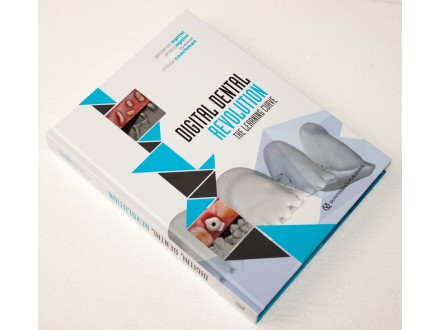Digital dental revolution - The learning curve + CD
| Cena: |
20.000 din
(Predmet je prodat)
|
| Stanje: | Nekorišćen |
| Garancija: | Ne |
| Isporuka: | Pošta CC paket (Pošta) Post Express Lično preuzimanje |
| Plaćanje: | Tekući račun (pre slanja) Lično |
| Grad: |
Beograd-Zemun, Beograd-Zemun |
ISBN: Ostalo
Godina izdanja: 2017
Jezik: Engleski
Oblast: Stomatologija
Autor: Strani
Autor: Alessandro Agnini, Andrea Agnini, Christian Coachman
Izdavač: Quintessence Publishing, 2017.
Tvrd povez, 400 str.
Format: 288 x 215 x 30 mm
Težina: 1955 gr
Digital dental revolution - The learning curve + CD
For many years systematized and well-established conventional protocols have been used in prosthetic rehabilitations, yielding results that met clinicians’ expectations and often exceeded those of patients. Over time the advent of new technologies and new materials has enabled the dental team to create prosthetic rehabilitations with an accuracy and precision that were previously difficult to obtain. Today, intraoral scanning technology is one of the most exciting new areas in dentistry, with three-dimensional digital reconstruction of the oral structures facilitating a wide range of procedures in fields such as prosthodontics, implant dentistry, and orthodontics. Currently available intraoral scanners overcome many of the limitations and disadvantages of traditional impression procedures while maintaining a high level of accuracy, making them an efficacious alternative to conventional impression techniques. In this book, the authors introduce the protocol they have used in their own practice, integrating new digital technologies and advanced materials with experience gained from using traditional techniques to provide restorations with optimal strength, esthetics, and function while reducing treatment times and improving patient comfort. Many cases are presented, highlighting the modified protocols the authors have developed over time with their increasing knowledge of new materials and the ongoing development of new technology and demonstrating a level of quality in the results that is on par with if not superior to that achieved using conventional methods.
New Technologies
Tradition vs innovation: What has changed?
Traditional protocol work flow
Technical work flow with CAD/CAM technology
Material selection and treatment plan sequencing
Zirconia
Mechanical properties of zirconia ceramics
CAD/CAM technology for fabrication of zirconia abutments and frameworks for crowns and fixed dental prostheses
Considerations for using zirconia as a restorative material
Considerations for fixed implant restoration designs
Zirconia abutments
Recommended clinical protocols
Diagnosis and Communication
Smile analysis and esthetic designs
Initiating smile analysis: Evaluating facial and orofacial esthetics
Evaluating oral esthetics
Dentogingival esthetics
Digital Smile Design approach
DSD protocol: Esthetic diagnosis, Communication, Feedback, Patient management, Education
DSD work flow
DSD concept goals
Smile design test drive
DSD Connect
The four DSD views
The Digital Impression
Digital impressions in the literature
The digital work flow
The Zfx intraoral scanner
Highlights of the system
Important areas
Areas of less importance
Target area definition
General scan
Checking and finishing phase
Learning curve
Knife-edge preparation: A possibility with new materials?
Zirconia and new technologies
New customized abutment design: Zirconia inside laminate (ZIL)
Is it possible to apply ZIL in the anterior dentition?
Soft tissue displacement: Indications, purpose, and techniques
Impression objectives
Implants and digital impressions
Surgical procedure
Tooth extraction
Implant placement
Trabecular Metal Material
Gap management
Provisional restoration fabrication
Connective tissue graft augmentation
Bone graft augmentation
Digital impression taking
Technical work flow
Protocol for overbuilding of the socket site
CAD/CAM implant abutments: The true advantage
Titanium or zirconia abutments: What is the rationale?
Treatment planning in complex cases
Patient complaint and history
Preliminary tests and treatment
Diagnosis and treatment plan
Surgical phase
Immediate provisional restoration
Definitive restoration work flow
Advantages of three-dimensional dental imaging
Surgical phase
Prosthetic phase
Definitive restoration: The role of digital dentistry
Scanning strategy: A critical step for success
Passive fit
The New Digital Possibilities
Monolithic zirconia: Why and when
Zfx Zirconium Effect 2.0 Multilayer
Combining clinical experience: Monolithic zirconia crowns and digital impressions for a predictable restorative alternative
Preliminary healing time
Monolithic zirconia and intraoral scanner: Predictable for complex rehabilitations?
Cementation: Finalization of the prosthetic rehabilitation
New implant materials
Trabecular Metal implant rationale
Definitive prosthetic phase
POGLEDAJTE I OSTALE KNJIGE KOJE PRODAJEM
KLIKNITE NA LINK
https://www.kupindo.com/pretraga.php?Prodavac=madena&Grupa=1
Predmet: 46722037







